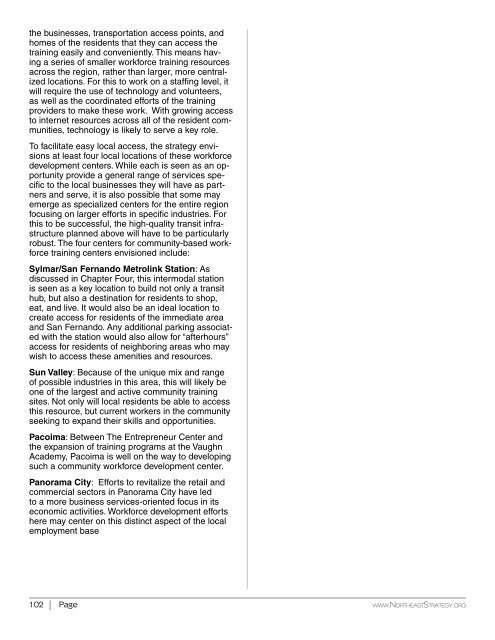Northeast San Fernando Valley
NEV%20Strategy%20Publication%20Draft%20Revision%20I
NEV%20Strategy%20Publication%20Draft%20Revision%20I
You also want an ePaper? Increase the reach of your titles
YUMPU automatically turns print PDFs into web optimized ePapers that Google loves.
the businesses, transportation access points, and<br />
homes of the residents that they can access the<br />
training easily and conveniently. This means having<br />
a series of smaller workforce training resources<br />
across the region, rather than larger, more centralized<br />
locations. For this to work on a staffing level, it<br />
will require the use of technology and volunteers,<br />
as well as the coordinated efforts of the training<br />
providers to make these work. With growing access<br />
to internet resources across all of the resident communities,<br />
technology is likely to serve a key role.<br />
To facilitate easy local access, the strategy envisions<br />
at least four local locations of these workforce<br />
development centers. While each is seen as an opportunity<br />
provide a general range of services specific<br />
to the local businesses they will have as partners<br />
and serve, it is also possible that some may<br />
emerge as specialized centers for the entire region<br />
focusing on larger efforts in specific industries. For<br />
this to be successful, the high-quality transit infrastructure<br />
planned above will have to be particularly<br />
robust. The four centers for community-based workforce<br />
training centers envisioned include:<br />
Sylmar/<strong>San</strong> <strong>Fernando</strong> Metrolink Station: As<br />
discussed in Chapter Four, this intermodal station<br />
is seen as a key location to build not only a transit<br />
hub, but also a destination for residents to shop,<br />
eat, and live. It would also be an ideal location to<br />
create access for residents of the immediate area<br />
and <strong>San</strong> <strong>Fernando</strong>. Any additional parking associated<br />
with the station would also allow for “afterhours”<br />
access for residents of neighboring areas who may<br />
wish to access these amenities and resources.<br />
Sun <strong>Valley</strong>: Because of the unique mix and range<br />
of possible industries in this area, this will likely be<br />
one of the largest and active community training<br />
sites. Not only will local residents be able to access<br />
this resource, but current workers in the community<br />
seeking to expand their skills and opportunities.<br />
Pacoima: Between The Entrepreneur Center and<br />
the expansion of training programs at the Vaughn<br />
Academy, Pacoima is well on the way to developing<br />
such a community workforce development center.<br />
Panorama City: Efforts to revitalize the retail and<br />
commercial sectors in Panorama City have led<br />
to a more business services-oriented focus in its<br />
economic activities. Workforce development efforts<br />
here may center on this distinct aspect of the local<br />
employment base<br />
Goals and Metrics<br />
Location Efficiency<br />
The location efficiency outcome reflects the degree<br />
to which improved coordination of land use<br />
and transportation planning impacts the movement<br />
of people and goods in the <strong>Northeast</strong> <strong>Valley</strong>. This<br />
outcome has several associated performance measures<br />
that will be used for monitoring the degree to<br />
which the region is advancing toward our Location<br />
Efficiency goals:<br />
1. Increase in area classified as High Quality<br />
Transit Areas (HQTAs)<br />
2. Share of growth confined to<br />
HQTAs<br />
3. Reduced land consumption relative to<br />
growth<br />
4. Reduction of per capita Vehicle Miles Traveled<br />
(VMT)<br />
5. Increase in Transit Mode Share to public<br />
transportation - boardings<br />
6. Ruduction in average distance for work<br />
and non-work trips<br />
7. Increased percentage of trips less than<br />
three miles<br />
8. Improved balance of local jobs to local<br />
residents and housing<br />
9. High public transit ridership in East <strong>San</strong><br />
<strong>Fernando</strong> <strong>Valley</strong> Transit Corridor<br />
In addition to these nine metrics, measures of mobility<br />
and accessibility also serve to further reinforce<br />
the importance of the location efficiency outcome. 1<br />
Broad-Based Prosperity<br />
1. Increase in median household incomes<br />
2. Increase in locally owned and operated<br />
businesses<br />
3. Increase in local participation in college<br />
and post-secondary achievement<br />
4. Increase in industrial base<br />
5. Number and quality of local businesses<br />
and amenities, offering quality goods and<br />
services<br />
6. Reduction in concentrations and pockets<br />
of poverty<br />
7. Reduction in poverty-serving establishments<br />
such as alcohol and drug-related<br />
outlets<br />
Environmental Remediation and<br />
Enhancement<br />
See CalEnviroScreen (Appendix A)for objective<br />
measurements of many of the following metrics.<br />
1. Quantifiable reductions in toxins and pollutants,<br />
involving, ozone, pesticides, PM<br />
2.5, Chemical Releases, Diesel, Water<br />
Pollution, and solid waste burdens<br />
2. Improved health care outcomes, including,<br />
Asthma and Low Birth Weight<br />
3. Reduction of social and economic disadvantages,<br />
including, Unemployment,<br />
Limited Education, Linguistic Isolation and<br />
Poverty<br />
4. Aesthetic improvements and development<br />
of Town Centers that include healthy and<br />
sustainable streetscapes, with street trees<br />
and shrubbery, as well as stimulating experiences<br />
at the human scale<br />
5. Protection of natural elements and open<br />
spaces, as well as the special rural features<br />
that are unique to the <strong>Northeast</strong><br />
<strong>Valley</strong><br />
1 Derived from the Southern California Association of Governments<br />
(SCAG) 2016-2040 Draft RTP/SCS, p.154<br />
102 Page www.<strong>Northeast</strong>Strategy.org<br />
Draft Revision I - May 25, 2016<br />
Page 103


